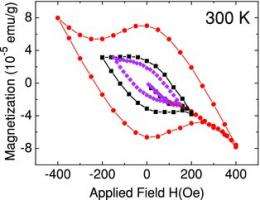September 19, 2012 report
Researchers find water doped graphite flakes exhibit superconductive properties at high temperature

(Phys.org)—Researchers from the University of Leipzig have found that doping very small flakes of graphite with water, then allowing it to dry, results in a material that behaves very much like a superconductor. The team, led by Pablo Esquinazi have written a paper describing their process and results and have had it published in the peer review journal Advanced Materials. If their findings prove sound, the discovery would almost certainly revolutionize the electronics industry.
A superconductor is a material that conducts electricity without resistance, which means no loss of energy; researchers have been searching for such a material that operates at room temperature (many materials are superconductors at very cold temperatures) for a number of years without success. Much of the recent research in this area has focused on carbon atom based substances such as graphene, nanotubes and graphite because of their unique lattice structures, but thus far, no one has been able to figure out a way to use any of them to produce a material that superconducts at room temperature.
In this new research, the team built on previous research that showed that graphite becomes superconductive at very low temperatures when doped with various substances. They wondered if a material could be produced that would be superconductive at higher temperatures if they could find the right dopant. For simplicity's sake, they started with plain water.
They soaked a graphite powder (made up of tiny flakes) in water for just under a day, then filtered out the powder and let it dry in a 100 °C oven, then placed it in a magnetized field, then withdrew it. They found the material remained magnetized, which suggested it was a superconductor. To rule out the possibility that it was simply ferromagnetic, they ran several runs using different levels of magnetism and temperature and found that when plotting out the results, they resembled those for a superconductor. The next obvious step would be to put the powder together and run a charge through it to see if it conducted without resistance, but all of their efforts to do so caused a change in the material resulting in the loss of the superconductivity property, which means of course, that no one knows if the stuff is truly a superconductor that works at room temperature.
The team believes that what happens is electrons form in high concentrations where the flakes interface, and that adding water somehow causes them to bond. The resulting material, if truly superconductive would be so only on its surface, which would mean rethinking how electricity might be transmitted using such a material. In any case, the work will be thoroughly scrutinized through a peer review process and if other's find the same properties, new research will be done to see if a way might be found to string the flakes together to create a wire of some sort that might be tested to see if what the German team found, really is a room temperature superconductive material.
More information: Can Doping Graphite Trigger Room Temperature Superconductivity? Evidence for Granular High-Temperature Superconductivity in Water-Treated Graphite Powder, T. Scheike, W. Böhlmann, P. Esquinazi, J. Barzola-Quiquia, A. Ballestar, A. Setzer, Article first published online: 5 SEP 2012. DOI: 10.1002/adma.201202219 . ArXiv pre-print
Abstract
Granular superconductivity in powders of small graphite grains (several tens of micrometers) is demonstrated after treatment with pure water. The temperature, magnetic field and time dependence of the magnetic moment of the treated graphite powder provides evidence for the existence of superconducting vortices with some similarities to high-temperature granular superconducting oxides but even at temperatures above 300 K. Room temperature superconductivity in doped graphite or at its interfaces appears to be possible.
Journal information: Advanced Materials
© 2012 Phys.org



















